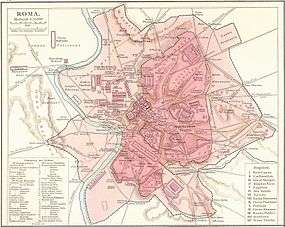Flavian Palace
Coordinates: 41°53′19″N 12°29′12″E / 41.88861°N 12.48667°E
| Domus Flavia | |
|---|---|
 Domus Flavia and Circus Maximus | |
| Location | Palatine Hill |
| Built in | 92 AD |
| Built by/for | Domitian |
| Type of structure | Domus |
| Related |
List of ancient monuments in Rome |
 Domus Flavia | |
The Flavian Palace, also known as the Domus Flavia or Domus Augustana, is the vast residential complex of the Roman Emperors on the Palatine Hill in Rome. It was completed in 92 AD during the reign of Titus Flavius Domitianus, more commonly known as the Emperor Domitian,[1] and attributed to his master architect, Rabirius.[2]
The term Domus Flavia is a modern invention used to describe the northern section of the Domitianic Palace, that designed for public ceremony, reception, and entertainment.[3] It is interconnected with the domestic wing to the south, though in Antiquity the Palace was always referred to as one unit, the Domus Augustana.
The imposing ruins which flank the southwestern side of the Palace above the Circus Maximus are a later addition built by Septimius Severus; they are the supporting piers for a large extension which completely covered the western slope.
Layout
Domitian's Palace contains several exceptionally large rooms; the main public reception rooms are the Basilica, the Aula Regia, the Lararium, and the Triclinium. The Basilica is the first part of the palace visible from the Clivus Palatinus, the road that connects the Roman Forum to the Palatine Hill. It is a long room with a central nave where the Emperor presided over legal cases and performed his judicial functions. The next room is the Aula Regia, one of the biggest rooms in the palace. In the time of Domitian, the walls had a marble veneer, and there were Phrygian marble columns and an elaborately carved frieze. The Aula Regia was used for the daily "salutatio" to the Emperor and to host important receptions and embassies. The third room, the Lararium, is the smallest and most poorly preserved room in the palace. Behind it was once a staircase providing access to the Domus Augustana. There was also a huge peristyle garden with suites of rooms to the north and south. The Triclinium or Banqueting Room, along the west side of the peristyle, is the 2nd largest room in the Palace. Like the Aula Regia, it was extravagantly decorated, with several tiers of columns in exotic marbles and a frieze. It opened onto two courtyards with oval fountains to the north and south.[2]
.png) Map of Aula Regia
Map of Aula Regia Northern part of Domus Flavia (Aula Regia, basilica and lararium)
Northern part of Domus Flavia (Aula Regia, basilica and lararium) Center part (peristilium)
Center part (peristilium) Southern part (Cenatio Iovis)
Southern part (Cenatio Iovis)
The Flavian Palace in contemporary times
The poet Statius, a contemporary of Domitian, described the splendor of the Flavian Palace in Silvae, IV, 2:
Awesome and vast is the edifice, distinguished not by a hundred columns but by as many as could shoulder the gods and the sky if Atlas were let off. The Thunderer’s palace next door gapes at it and the gods rejoice that you are lodged in a like abode […]: so great extends the structure and the sweep of the far-flung hall, more expansive than that of an open plain, embracing much enclosed sky and lesser only than its master.[4]
Scholars usually identify this room as the Triclinium, but it could possibly be the Aula Regia, which was distinguished by its number of columns.[2]
The Flavian Palace was one of Domitian’s many architectural projects, which also included the Domus Augustana, a contribution to the Circus Maximus, a contribution to the Pantheon, and three temples deifying his family members: the temple of Vespasian and Titus, the Porticus Diuorum, and the Temple of the gens Flavia.[2]
See also
| Wikimedia Commons has media related to Domus Flavia. |
- Domus
- Roman architecture
- List of Roman domes
- List of Greco-Roman roofs
- History of Roman and Byzantine domes
References
- ↑ The Cambridge Ancient History. Vol. XI. Cambridge: Cambridge University Press, 2000.
- 1 2 3 4 Darwall-Smith, Robin Haydon. Emperors and Architecture: A Study of Flavian Rome. Brussels: Latomus Revue D'Etudes Latines, 1996.
- ↑ Robathan, Dorothy M. "Domitian's 'Midas-Touch'". Transactions and Proceedings of the American Philological Association 73 (1942): 130-144.
- ↑ Statius. Silvae IV. Trans. K.M. Coleman. Oxford: Clarendon Press, 1988.